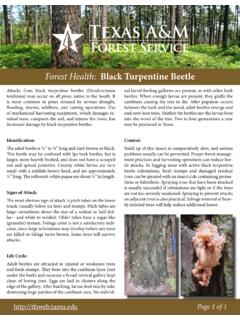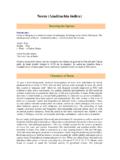Transcription of COMMON TREE HEALTH PROBLEMS - Connecticut
1 Dr. Sharon M. Douglas Department of Plant Pathology and Ecology The Connecticut Agricultural Experiment Station 123 Huntington Street, P. O. Box 1106 New Haven, CT 06504 Phone: (203) 974-8601 Fax: (203) 974-8502 Email: COMMON tree HEALTH PROBLEMS There are a number of diseases that can be considered of general importance or COMMON occurrence for many different tree species. This fact sheet covers most of the COMMON abiotic and biotic PROBLEMS and provides a general description of the symptoms of each disease and the general strategies for managing each problem . COMMON ABIOTIC PROBLEMS : 1. Drought Symptoms of drought stress can occur on woody plants in the landscape, in natural woodlots, and in forests. Prior to 2003, weather records from the Experiment Station s Lockwood Farm in Mt.
2 Carmel indicated that a trend for abnormally low levels of precipitation had been occurring since 1995, which was characterized as the worst drought in 30 years and as the driest summer since 1944. With a pattern of several consecutive dry seasons, many woody plants including drought-sensitive as well as species that are normally considered drought-tolerant can exhibit symptoms of drought stress. When trying to define a drought year, the pattern and frequency of precipitation is more important than the total amount of precipitation recorded for the year. Total precipitation levels can be deceiving when interpreted solely on the basis of yearly amounts rather than on a month-by-month basis. This is because one or two significant precipitation events or storms in a year could account for much of the total precipitation recorded for that year.
3 Therefore, it is the amount and frequency of precipitation rather than yearly totals that are important to the long-term HEALTH , growth, and vigor of woody plants. This is especially true during the growing season when water demands are the greatest. Up-to-date information on precipitation levels recorded at the Experiment Station s Lockwood Farm can be found on the CAES web site ( ). Drought or dry soil results in damage and death of the roots. The root system of a woody plant has four types of roots: 1) framework roots consisting of primary and secondary woody roots, 2) transport and storage roots, 3) non-woody feeder roots, and 4) root hairs. Almost 99% of this root mass is in the top three feet of the soil. The feeder roots and root hairs, which are in the top 12 inches of the soil, are responsible for uptake of water and nutrients.
4 Unfortunately, they are the first portion of the root system to be affected by drought since they are very sensitive to drying. When feeder roots and root hairs become nonfunctional, a water deficit develops in the plant because these roots can no longer provide sufficient water to the top of the plant. In addition to direct damage to the root system, drought triggers metabolic changes. Among these S. M. Douglas, The Connecticut Agricultural Experiment Station, New Haven, CT are changes in hormone levels and other physiological factors ( , factors that influence the number of leaves that will emerge the next year or that are responsible for the closing of stomates). SYMPTOMS: Symptoms of drought are manifest in many different ways depending on the plant species and the severity of the water deficit.
5 One important aspect of drought is the fact that the symptoms are often not evident in the top of the tree or shrub until sometime after the event has occurred--even as much as one to two years later. Symptoms include loss of turgor in needles and leaves, drooping, wilting, yellowing, premature leaf or needle drop, bark cracks, and twig and branch dieback. Leaves on deciduous trees often develop a marginal scorch and interveinal necrosis whereas needles on evergreens turn brown at the tips. Trees and shrubs can also exhibit general thinning of the canopy, poor growth, and stunting. In extreme cases, drought can result in plant death. In addition to direct root damage, a significant secondary effect of drought is that it weakens plants and predisposes them to secondary invaders and opportunistic pests such as fungal tip blights, vascular wilts, root rots, and needlecasts.
6 Many drought-stressed plants also show increased sensitivity to de-icing salts, air pollutants, and pesticides to which they are exposed. Native plants growing naturally in woodlots or forested areas are usually adapted to regional and seasonal fluctuations in the amount of precipitation and only unusually severe drought causes PROBLEMS for them. However, planted landscape trees and shrubs often show symptoms of drought and severe water stress. Planting practices are frequently key sources of this problem since we often plant in unfavorable sites, don t prepare the rootball properly, plant too deep or too shallow, or mulch so thickly that water doesn t penetrate into the soil. Symptoms of drought can develop on a wide range of deciduous and evergreen trees and shrubs and are particularly severe on seedlings and new transplants.
7 This is because their roots occupy the uppermost layers of soil where the most rapid drying occurs. In addition, recent transplants typically lose important feeder roots during the transplant process. For example, balled and burlapped trees are estimated to contain only 5-20% of their original root mass after digging. For container-grown ornamentals, the medium in which the transplant is growing can be a key factor--many of the soilless mixes used for container stock are highly porous, dry out very quickly, and are very difficult to re-wet. This situation creates moisture stress in the rootball regardless of the availability of water in the surrounding soil. This problem often continues until the roots grow beyond the rootball.
8 Contrary to popular opinion, it often takes woody transplants two years to become completely established in a new site. Thus, these plants should be given extra care and attention during periods of drought. Established trees and shrubs are also affected by drought, especially those in marginal sites, , with pavement over their roots, street trees, in pockets of soil on ledges, or in sandy soils. PROBLEMS have also been observed on apparently established trees and shrubs that have survived despite improper planting. Once stressed by drought, these trees quickly decline and often die. MANAGEMENT STRATEGIES: S. M. Douglas, The Connecticut Agricultural Experiment Station, New Haven, CT 2 While there is no cure for this problem , the effects of drought can be minimized by following some preventative measures: Water in periods of low soil moisture: trees and shrubs require approximately one inch of water per week.
9 This is best applied at one time as a slow, deep soaking to a depth of approximately 12-18 inches. The length of time required to deep-water will vary depending on soil type and water pressure: clay soils usually require more time than sandy soils. Frequent, light, surface watering will not help the tree and can actually cause harm by promoting growth of surface roots. A deep soaking just before the ground freezes in the fall will also help the winter hardiness of drought-stressed plants. Select an appropriate site and follow good planting practices; drought stress can magnify even subtle improper planting practices. Select native plants or match plant species to site conditions: drought-sensitive (dogwood, some oaks, arborvitae) vs.
10 Drought-tolerant (most pines, many Prunus, larch, junipers). Mulch to maintain soil moisture. Prune any dead or weakened tissues to avoid secondary PROBLEMS . Maintain plant vigor by following good cultural practices. 2. Excess Water Excess water can be a serious problem for many woody ornamentals. Roots in flooded or waterlogged soils are damaged and die from oxygen deficiency. In addition to this direct damage to the root system, flooding has also been associated with inciting physiological changes in woody plants that influence their growth and other processes. The feeder roots, which are non-woody and important for uptake of water and nutrients from the soil, are particularly sensitive and are frequently the first ones damaged by waterlogged conditions.

















